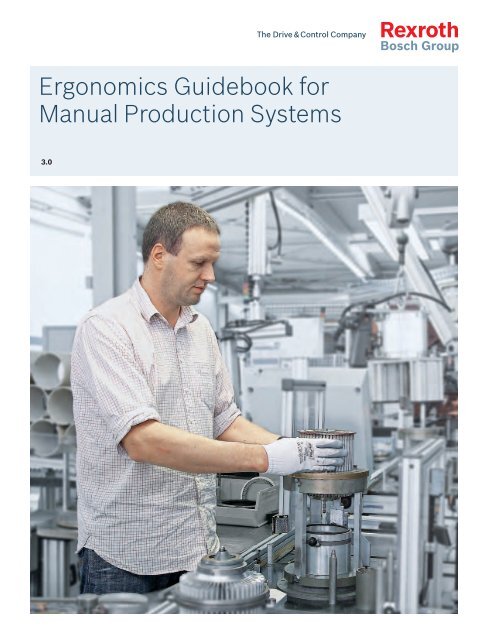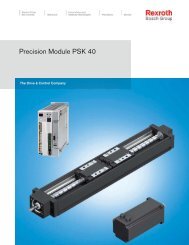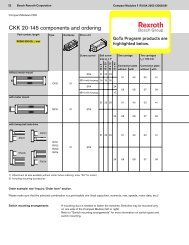Ergonomics Guidebook - Bosch Rexroth Corp.
Ergonomics Guidebook - Bosch Rexroth Corp.
Ergonomics Guidebook - Bosch Rexroth Corp.
- No tags were found...
You also want an ePaper? Increase the reach of your titles
YUMPU automatically turns print PDFs into web optimized ePapers that Google loves.
2The eight rules of ergonomicsfor work systemsBody height 04 Work area 06 Reach zone 08 Parts presentation 09Range of vision 10 Lighting 11 Equipment adjustments 12 Planning aids 14Benefit from ergonomicsUse the advantages of an ergonomically designed workstation system.We can support you with this and provide valuable suggestions. One exampleis this ergonomics guidebook, which contains the eight key rules of ergonomics,covering the most essential aspects of EN ISO 6385.This guidebook is a reference to help you methodically plan and implement ergonomicworkstations and flow racks. Among other things, it takes employee size, tasks, andlighting into account.
3<strong>Ergonomics</strong> – For motivated employees, higher productivity, and better qualityAn ergonomic workstation facilitates work and maintains good employee health.The results: Increased motivation and satisfaction, higher performance, efficiency,and processing quality, as well as fewer absences due to illness. The bottom line:<strong>Ergonomics</strong> provide you with valuable benefits in the form of higher productivity,increased efficiency, and a decisive edge over the competition – thus ensuringlasting success for your company.04 Body height and working height06 Work area08 Reach zone09 Parts presentation10 Range of vision11 Lighting12 Adjustment of work equipment14 Planning and design tools
5Definition of the table heightThe table height follows from the optimum working heightminus the height of the workpiece or insertion point. Toensure sufficient leg room for those in body height group 4as well, we recommend a minimum height of 1000 mm forsit-down and stand-up workstations. Further criteria thatmust be taken into account:ffFoot and leg room, depth and adjustment range ofthe footrestffSize and variation of workpiece dimensionsffOccurring forces and weightsffChanging types of equipment and insert heightsffGreatly varying vision distancesffLocal specifications (deviating body heights, legalrequirements, etc.)ffAspects related to methods, safety, and efficiencyRelevant parameters:For defining the table heightfor a sit-down/stand-up workstationTable heightWorking height H<strong>Rexroth</strong>'s sit-down/stand-up concept for productionThe sit-down/stand-up concept developed andrecommended by <strong>Rexroth</strong> makes it possible to work atthe same height when sitting and standing. This largelycompensates for different body heights. The conceptpermits changes in posture, which reduces stress andincreases performance. This is not possible with a purelysit-down or stand-up workstation alone.Flow rack designThe container weight and type of activity are decisivewhen designing flow rack systems. We recommend thearrangement shown in the figure. The following aspectsshould also be taken into account for material supply andremoval:ffTotal load on the employee during the shiftffCountry-specific requirements and standardsRecommended working heights:A: Higher container weight, B: Lower container weightC: Occasional handlingBBCA1400 mm1100 mm600–750 mm400 mmC
9Parts presentationAll reach distances should be as short as possible to avoidunnecessary movements that add nothing to the value andthus avoid waste. Grab containers and parts containersthat are in direct reach of the employee are ideal. Theposition of these containers should enable a flowingmovement that curves upward away from the body whenparts are removed.The following aspects must be taken into consideration forparts supply:ffPositioning of all grab containers in areas A and BffThe more frequently a grab container is used, theshorter the reach distance should beffHeavy parts should be stored within reach in the lowercontainers to avoid unnecessary exertion (e.g. caused bylifting and lowering)ffBending of the torso below 800 mm places adisproportionate strain on the human bodyffUse of geometric and physical features of the partsduring parts transfer, e.g. through the use of a slide railor roller conveyorffArrangement of different-sized containers according toparts geometry, maximum weight, and refill cycleffReduction of time for parts supply and removal by up to68% (MTM – Method of Time Measurement). Employeescan concentrate on productive assembly workccLet our case lifters help you to keep sick days downffExchangeable material supply shuttles reduce setup times
10Range of visionFor optimal workstation design, it’s important to followrecommendations on proper ergonomics for vision as well.Range of vision from above:The field of view is red and the visual field is light gray.You can differentiate between two vision areas:ffIn the field of view (red vision area), several objects canbe seen in focus simultaneously without moving the eyesor head. Additional focusing for depth may be requiredhere.ffIn the visual field (light gray vision area), objects can beseen by moving the eyes, but not the head. Additionalfocusing for depth may also be necessary here.Head movements are required outside these ranges. Whenstanding, the angle of view is 30° from the horizontal planeand 45° when sitting.Definition of the assembly station and parts supplyThe following aspects must be taken into account duringplanning:ffAvoid unnecessary eye and head movementsffImplementing vision distances that are as identical aspossible eliminates refocusingffAvoid fastening locations not visible to the workerRange of vision from the side:The field of view is red and the visual field is light gray.Complying with these three recommendations facilitateswork and increases productivity. Every time you turn yourhead or change the direction of vision and refocus resultsin lost time and money. The exact values can be determinedvia the MTM procedure.60°45°30°
11LightingThe right light, adapted to the activity at the workstation, isa basic prerequisite for high efficiency and processingquality. Optimum lighting prevents premature fatigue,improves concentration, and reduces the risk of errors.Important aspects for planning workstation lighting include:ffAvoid strong contrastsffAvoid glare and reflectionffDIN EN 12464 and the table below contain the requiredmid-range lighting intensitiesLighting of test workstations that is free of shadows,flickering, and glare (see figure)The right <strong>Rexroth</strong> system light for every taskCalculation example for work top lighting<strong>Rexroth</strong> SL 78 (nominal luminance intensity) 681 lux(lamp-to-table distance = 1.25 m)+ ambient lighting 300 lux= work top luminance intensity of 800 luxTasksRough and average machine and assembly tasks such asturning, milling, and planingRequired luminanceintensity (lux)300Fine machine tasks with permissible deviations 500<strong>Rexroth</strong>SL 36 Duo<strong>Rexroth</strong>SL 72 /economic1) 1)<strong>Rexroth</strong>SL 781) 1) 1)<strong>Rexroth</strong> SL 78+ SL 36 DuoFine assembly tasks, e.g. telephones, winding mediumsizedcoils, marking, inspection, and measuring stationsVery fine assembly, e.g. measuring instruments, assemblyof tools, gauges, and equipment, precision mechanics andmicromechanics75010001) 1) 1) 1)1) 1)Assembly, inspection, and adjustment of extremely smallparts1500 1)1) Distance between the table top and light: 1.25 mLamp luminance intensity sufficient for taskLamp luminance intensity + ambient light (300 lux) sufficient for task
13A few important considerationsffWhen adjusting the chair and footrest, make sure thatthe thighs and calves form a right angleffInformation boards should be hung at eye level to avoidunnecessary head movementsffThe angle of the shelves for material supply should beadjusted to create short, direct reach distancesffUse lifting aids to supply heavy partsffMonitor brackets and tool shelves can be adjusted toany height via the profile slotffWith height-adjustable workstations, the optimumworking height can be adjusted according to the size ofthe person or product Information on how to adjust thework equipment can be provided on information boardsIf processes, products, or employees change frequently,check the work equipment regularly to ensure properergonomic adjustment.Separate adjustment of material feed height andworking height:Height-adjustable workstations can be adapted to boththe product and the worker.
















